

23 March to 15 July 2012 Jewish Migrants from Eastern Europe in the 1920s
David Koigen
-
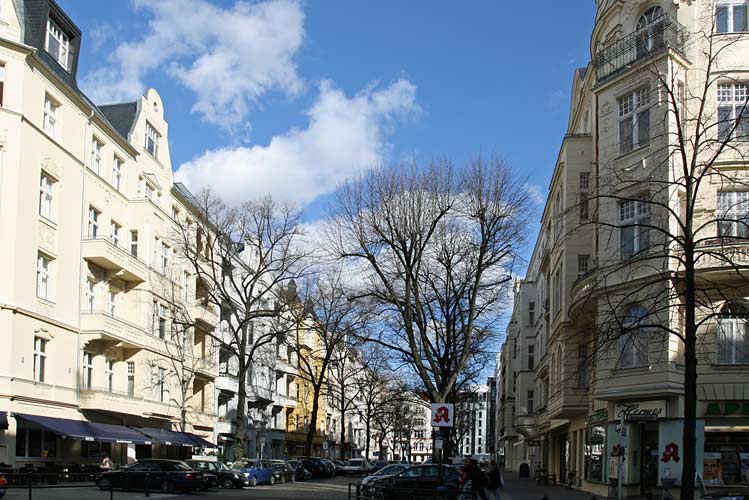
- Mommsenstr. in 2012 © Jewish Museum Berlin, photo: Gelia Eisert
Mounted just inside the entrance to Mommsenstrasse 3 is an information panel about the social philosopher David Koigen (1879–1933). The building’s current owner had the panel installed to commemorate the time Koigen lived there.
From 1930 until Koigen’s death in 1933, his apartment was the meeting place for a group of students, scholars, and journalists interested in religious philosophy. In addition to Albert Einstein, who directed the Kaiser Wilhelm Institute of Physics at the time, his guests included the Social Democratic politician Eduard Bernstein.
David Koigen emigrated from the Ukraine to Berlin in 1921. His works on cultural philosophy and the philosophy of social exchange established him as a well-known philosopher and sociologist in Germany.
David Koigen was given a traditional religious upbringing by his father, Mordechai Kohen.
After attending secondary school in Nemirov and Odessa, he studied philosophy in Bern, Zurich, Munich, Berlin, and Paris.
As was common for Russian-German cosmopolites, he spoke several languages, including Yiddish, Russian, German, and Hebrew.
He became a professor of philosophy and sociology at the University of Kiev in 1918, but never held a professorship in Germany.
From 1925 to 1927, Koigen published the journal Ethos together with the social psychologist Fischl Schneersohn and the educator Franz Hilker. The journal sought to define a new social ethics after the disaster of the First World War. Koigen’s political vision was of a Europe in which all people, even Jews, enjoyed human rights and civil liberties.
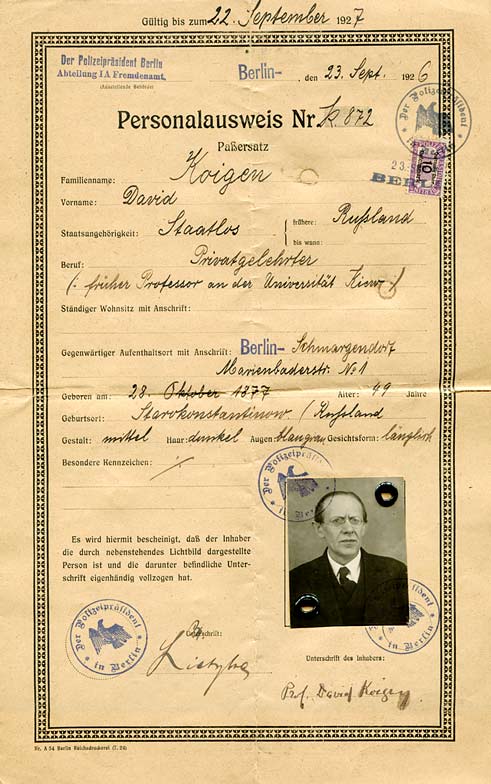
- David Koigen’s German identity document (replacement passport) with the entry “stateless,” 1926, © private collection of Mira Zakai, Israel—Helene und David Koigen’s granddaughter
David Koigen was one of the few Jewish immigrants in the Weimar Republic to receive German citizenship. In response to the inflation crisis of 1925, Prussia had increased the minimum period of residence for “foreign-born” naturalization applicants from ten to twenty years.
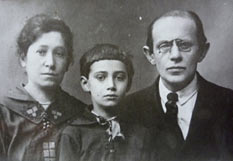
- Koigen family
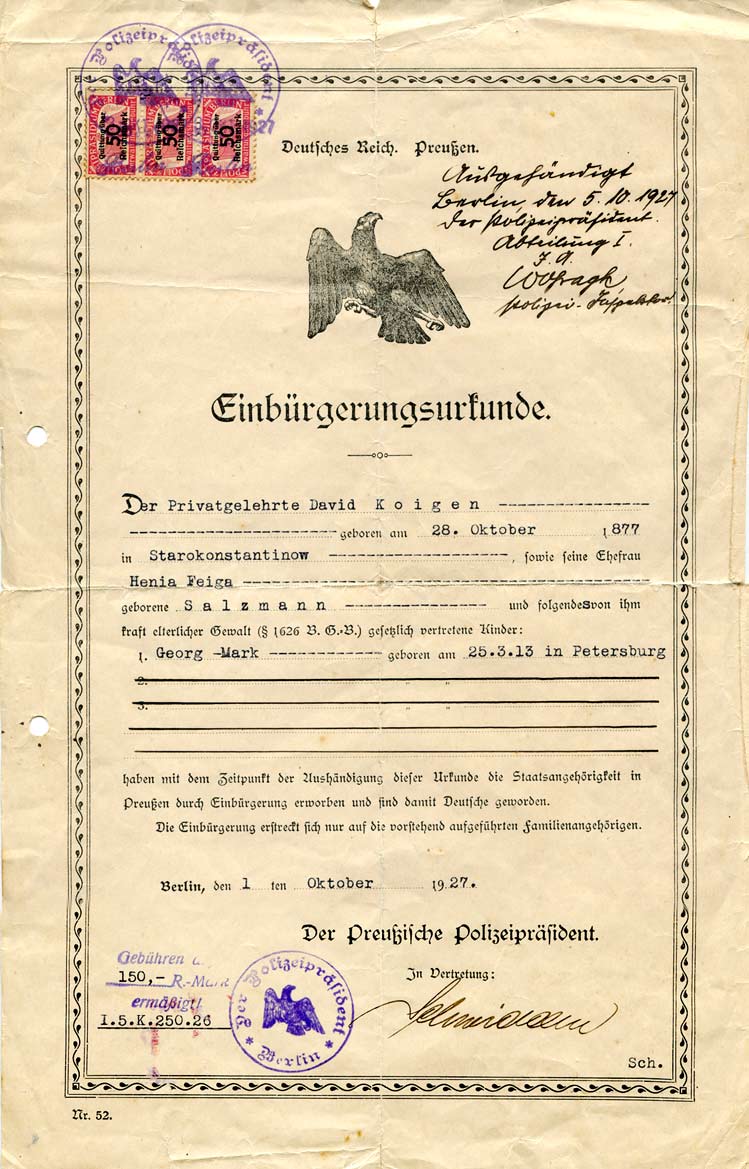
- David Koigen’s naturalization document from 1927 © private collection of Mira Zakai, Israel—Helene und David Koigen’s granddaughter
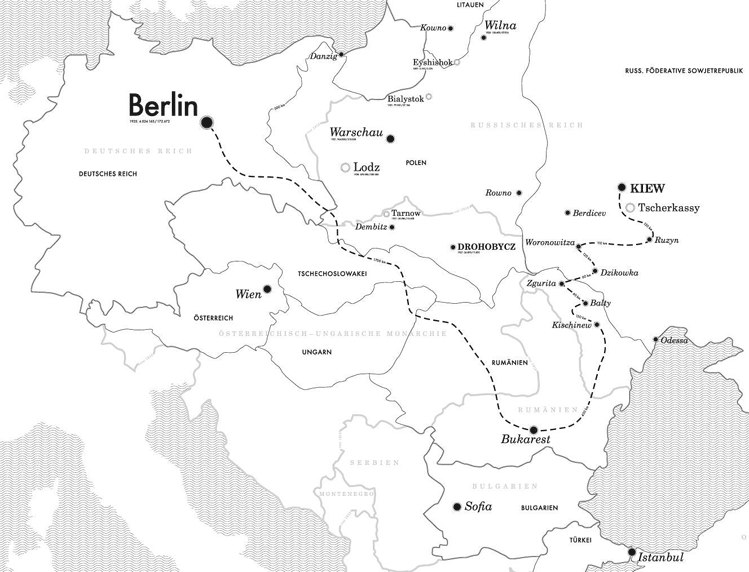
- Escape route taken by the Koigen family © chezweitz and partner
In the winter of 1920/1921, David Koigen fled Kiev and the repressive policies of the Bolsheviks together with his wife, Helene, and their eight-year-old son.
The family managed to escape from the occupied city by hiding first in a cattle car and then in a military train. Braving snow and frost, they then traveled around 340 kilometers to the Romanian border, crossing illegally on foot at night over the frozen Dniester River. The family eventually reached Berlin via Kishinev and Bucharest.
In his autobiographic work Apocalyptic Horsemen, David Koigen described the years he spent in Kiev, the family’s escape to Germany via Romania, and the traumatic experience of violence and pogroms during the Russian Civil War.
Civil War and Pogroms:
World War I and the Russian Revolution of 1917 dramatically changed the political map of Europe. When the great multiethnic empires collapsed, Jews got caught between the fronts of the new nation-states. As a minority, they were often suspected of espionage.
During the Russian Civil War, the warring parties carried out around 1,500 pogroms at 1,300 sites on the territory of the present-day Ukraine. Hundreds of thousands of Jews were killed and half a million lost their homeland. They fled the cities and villages of both the Russian Empire and the Habsburg Monarchy, taking circuitous routes to Berlin.
David Koigen, Apocalyptic Horsemen
»I can still remember the feeling that took hold of me when I prepared to move from here to Russia one year before the World War. I occasionally talked to German friends, who tried to dissuade me from my plan. ›You would hardly understand,‹ I said to them. ›We Jewish Europeans—or Jewish Eastern Europeans, if you like—long for history more than anything else….‹
Later, when ‘history’ was happening, when it crashed over us Jewish Europeans in all its fury, spreading dreadful misery among us, I often had the opportunity to cogitate on the historical metaphysics that is in our blood....
While I was still hesitantly weighing my plan within my circle of initiates to escape from Kiev, total strangers would express their astonishment at the fact they were still seeing me in the city. The primary goal was to break through the magic circle that had been cast around our lives and our city by the ›extraordinary institutions‹ of Bolshevik power…. After two weeks of running from pillar to post, all that was left for me to do was to visit the ›Extraordinary Commission of the Red Army.‹ For three consecutive days, we froze in front of that infamous building….
At five o’clock on a beautiful winter morning, I made my way to the train station pushing the loaded cart that the residents of Kiev derisively called ›Trotzki’s carriage.‹ My wife said to me sadly, ›This is how the Jews made their exodus from Egypt.‹ But my eight-year-old boy was overjoyed that we were now taking the Bolshevik Pharaoh by surprise….
In Europe again, old and eternally young Europe, full of movement. Romanian gendarmes guarding the Romanian border, Bessarabia, Romania—all of this means nothing. Freedom, freedom!«
From: David Koigen, Apokalyptische Reiter: Aufzeichnungen aus der jüngsten Geschichte (Berlin: Erich Reiss Verlag, 1925)
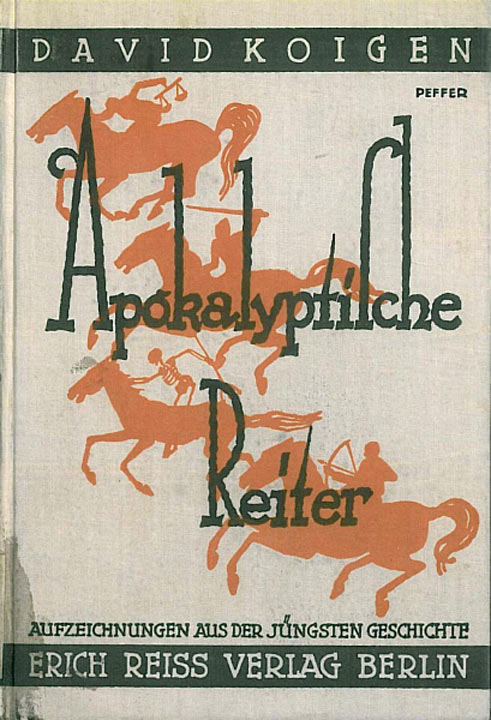
- David Koigen: Apocalyptic Horsemen: Notes from Recent Jewish History, 1925 (Erich Reiss Verlag Berlin, cover design by E. Peffer)
This bowl comes from the household of Helene Koigen (née Salzmann) and her husband, David, and is still in the possession of family members today. The Hebrew inscription on the back reads:
»Be-hakarat toda [in grateful recognition]
Grunewald Group
Hanukkah 5692 [=1930]«
Grunewald Group
At the delegates’ meeting held by the Berlin Zionist Organization in 1922, the representatives of the Zionist Women’s Associations merged to form the Zionist Women’s League. Their goal was to overcome the isolation of Zionist women and improve ties among them. Many smaller Zionist women’s groups were formed, including nine in Berlin between 1925 and 1929. One was the Grunewald Group, which was led by Helene Koigen and had between 40 and 100 members.
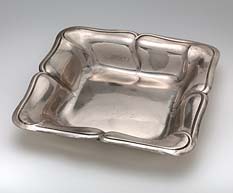
- Bowl dedicated to the Grunewald Group, from the private collection of Helene Koigen,
© Professor Mira Zakai, Givataim
Deutsch


